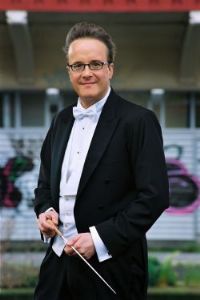|
Symphony
FROM THE NEW WORLD TO THE OLD WORLD
by Peter Lert
Saturday, June 14, 2025
Chamber
MC2 DUO RECITAL CLOSES 222'S SEASON
by Terry McNeill
Saturday, June 14, 2025
Choral and Vocal
CANTIAMO SONOMA'S LUSCIOUS A CAPELLA SINGING IN SEASON ENDING CONCERT
by Pamela Hicks Gailey
Sunday, June 8, 2025
Symphony
SRS SEASON ENDS WITH RESOUNDING TA-TA-TA-BANG
by Terry McNeill
Sunday, June 1, 2025
Symphony
YOUTHFUL VIRTUOSITY ON DISPLAY AT USO'S MAY CONCERTS
by Peter Lert
Saturday, May 17, 2025
Symphony
MYSTICAL PLANETS AND LIVELY GERSHWIN ORTIZ AT FINAL SRS CONCERT
by Peter Lert
Sunday, May 4, 2025
Symphony
VSO'S CONCERT MUSIC OF TIME, MUSIC OF PLACE
by Peter Lert
Sunday, April 27, 2025
VOCAL ELEGANCE AND FIRE AT THE 222'S RECITAL APRIL 26
by Pamela Hicks Gailey
Saturday, April 26, 2025
CANTIAMO SONOMA SINGS AN INSPIRED GOOD FRIDAY MOZART REQUIEM CONCERT
by Pamela Hicks Gailey
Friday, April 18, 2025
DRAMATIC SHOSTAKOVICH SYMPHONY CLOSES PHILHARMONIC'S 25TH SEASON
by Terry McNeill
Sunday, April 13, 2025
|
 |
 Conductor Marc Taddei |
TADDEI TRIUMPH IN VSO SEASON OPENING CONCERT
by Elizabeth Warnimont
Sunday, October 30, 2016
Vallejo Symphony Orchestra's guest soloist Sara Davis Buechner wowed her audience Oct. 30 in a stellar performance of Prokofiev’s Third Piano Concerto, the second of three pieces comprising the symphony’s season-opening performance in Hogan Auditorium and the debut of its new music director, Marc Taddei.
Mr. Taddei led the orchestra in a stunning performance of Haydn’s Sixth Symphony (Le Matin or “Morning”) Hob 1:6, followed by the Prokofiev and Sibelius’ Symphony No. 5, Op. 82.
“This program launches a season that has a number of distinct links,” Mr. Taddei explained to the audience. Haydn’s Symphony is the first of the composer’s three time-of-day symphonies, each of which will be featured in a different concert this season, and the Prokofiev concerto is one of the season’s three modern Russian concertos. The Sibelius E-Flat symphony belongs in the category of “masterpieces of the symphonic repertoire,” as Mr. Taddei describes it, and two others that he has placed such a group are Beethoven’s “Eroica” Symphony, which he says is the most important symphony ever written, and Tchaikovsky’s “Pathétique.”
The Orchestra sounded especially accomplished the opening Adagio-Allegro movement of the Haydn where slow crescendos and delicate flute and oboe sections introduce a gentle, spirited theme. The effect seemed lulling with delicate playing to the attentive audience while subtly but craftily planting seeds for the developments to come. In the second movement Adagio Andante the violins began to assert their voices in short solo segments, interspersed with colorful accompaniment by various sections. The music’s effect grew to a happy dancing climax that included particularly expressive playing from the cellos.
The highlight of the third (Minuet) movement’s performance was the interplay of bass and bassoon, something that sounded quite novel with provocative harmonies. In the Finale – Allegro movement there was lovely flute playing from Melanie Keller, reminiscent of earlier themes, and a return to cheerful concluding string phrases and a peaceful conclusion.
The Prokofiev C Major Concerto performance featured jaw-dropping virtuosity by Ms. Buechner that was both brilliant and oddly lacking volume at critical places in the score from 1921. Castanets, rarely a part of classical music, often sounded distractingly loud. As the music moved into the Theme and Variations and finale Allegro movements Ms. Buechner easily mastered the difficult accelerating passages. While there may have been moments during the 20-minute performance where soloist and orchestra balances were askew, especially in tricky rhythmic passages, the audience was swept away by the pianist’s luminous playing and sonorous power.
The program finished with Sibelius’ Fifth, described by Mr. Taddei as containing a mysterious, frenzied buzzing, and is punctuated with horns reminiscent of swans honking in flight, making the piece distinctly rich in sounds from nature. The “swan theme” is perhaps the most recognizable aspect of the work, and for Mr. Taddei “it’s just a very romantic piece and has such an interesting structure. It’s (a cornerstone of) early modernism.”
The work is indeed rife with buzzing from the string sections, covered with distinct, affecting horn playing in the opening Moderrato-Allegro-Presto movement. The conductor drew rich sound from the strings that was combined with sterling horn playing (Meredith Brown, principal) and elegant phrasing from bassoonist Karla Ekholm. A distinct marching beat developed in the second movement (Andante Mosso), mirroring rhythms in the horns. Just before the Symphony’s conclusion there came a surprising moment of solemnity, marked “Misterioso” in the score, that subsequently burst into a victorious finish.
During the conductor’s “Meet the Music” talk before the performance Mr. Taddei explained many of the technical aspects of the concert’s selections, punctuated with short audio clips, and also offered some interesting cultural and historical contexts for the pieces.
The VSO’s next concert is Jan. 29 and features cellist Zlatomir Fung in Shostakovich’s Concerto No. 1 in E-flat major, and Haydn’s “Noon” Symphony (No. 7) and Beethoven’s Op. 55 “Eroica.”
|

